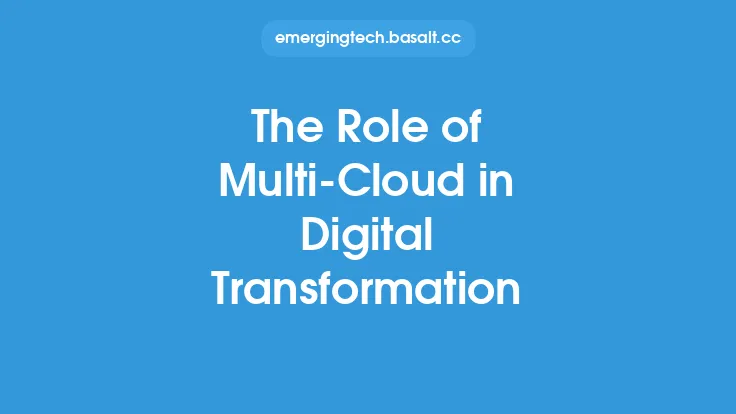As organizations continue to navigate the complexities of the digital landscape, two concepts have emerged as crucial components of modern IT strategies: cloud migration and digital transformation. While often discussed separately, these two ideas are deeply intertwined, and understanding their intersection is essential for businesses seeking to stay competitive in today's fast-paced digital economy.
Introduction to Cloud Migration
Cloud migration refers to the process of moving an organization's applications, data, and other computing resources from on-premises infrastructure to a cloud computing environment. This can involve transitioning to a public cloud, private cloud, or hybrid cloud setup, depending on the specific needs and goals of the organization. Cloud migration offers numerous benefits, including increased scalability, improved flexibility, and reduced costs. By migrating to the cloud, businesses can take advantage of on-demand resources, enhanced collaboration, and greater agility in responding to changing market conditions.
Understanding Digital Transformation
Digital transformation, on the other hand, is a broader concept that encompasses the integration of digital technology into all areas of a business, fundamentally changing how it operates and delivers value to customers. This transformation involves a cultural shift, requiring organizations to be more agile, innovative, and customer-centric. Digital transformation is driven by the need to stay competitive in a rapidly evolving digital landscape, where technological advancements are continually changing the way businesses interact with customers, partners, and other stakeholders. It involves leveraging technologies such as cloud computing, artificial intelligence, the Internet of Things (IoT), and data analytics to create new business models, improve operational efficiency, and enhance customer experiences.
The Intersection of Cloud Migration and Digital Transformation
The intersection of cloud migration and digital transformation is where the real power of these concepts comes into play. Cloud migration is often a critical step in a company's digital transformation journey. By moving to the cloud, organizations can gain the scalability, flexibility, and cost savings needed to support their digital transformation initiatives. The cloud provides a foundation for innovation, allowing businesses to quickly deploy new applications and services, experiment with new technologies, and respond to changing market conditions. Furthermore, cloud-based infrastructure can support the integration of various digital technologies, such as AI, blockchain, and IoT, which are key drivers of digital transformation.
Enabling Innovation and Agility
One of the primary ways in which cloud migration supports digital transformation is by enabling innovation and agility. Cloud computing provides businesses with on-demand access to a wide range of resources and services, allowing them to quickly develop, test, and deploy new applications and services. This agility is critical in today's fast-paced digital economy, where the ability to rapidly respond to changing market conditions and customer needs can be a key differentiator. Additionally, the cloud provides a platform for experimentation and innovation, allowing businesses to try out new ideas and technologies without the need for significant upfront investments in infrastructure.
Enhancing Customer Experiences
Another important aspect of the intersection between cloud migration and digital transformation is the enhancement of customer experiences. By leveraging cloud-based technologies, businesses can create more personalized, responsive, and engaging customer experiences. For example, cloud-based data analytics can provide insights into customer behavior and preferences, allowing businesses to tailor their offerings and interactions to meet specific needs. Additionally, cloud-based applications can support the creation of omnichannel experiences, where customers can interact with a business through multiple channels, including social media, mobile apps, and websites.
Supporting Data-Driven Decision Making
Cloud migration also supports digital transformation by providing businesses with the ability to make data-driven decisions. The cloud offers a range of data analytics and machine learning services, allowing organizations to gain insights into their operations, customers, and markets. This data can be used to inform strategic decisions, optimize operations, and identify new opportunities for growth and innovation. Furthermore, cloud-based data platforms can support the integration of data from multiple sources, providing a unified view of the business and enabling more effective decision making.
Security and Compliance Considerations
As businesses migrate to the cloud and undergo digital transformation, security and compliance become critical considerations. The cloud introduces new security risks, such as data breaches and cyber attacks, which must be mitigated through the implementation of robust security measures. Additionally, businesses must ensure that their cloud-based operations comply with relevant regulations and standards, such as GDPR, HIPAA, and PCI-DSS. This requires careful planning, monitoring, and management of cloud-based resources, as well as the implementation of compliance frameworks and security controls.
Conclusion
In conclusion, cloud migration and digital transformation are closely intertwined concepts that are essential for businesses seeking to stay competitive in today's digital economy. By migrating to the cloud, organizations can gain the scalability, flexibility, and cost savings needed to support their digital transformation initiatives. The cloud provides a foundation for innovation, enabling businesses to quickly deploy new applications and services, experiment with new technologies, and respond to changing market conditions. As businesses navigate the complexities of cloud migration and digital transformation, they must prioritize security, compliance, and customer experience, while leveraging the cloud to drive innovation, agility, and growth.





